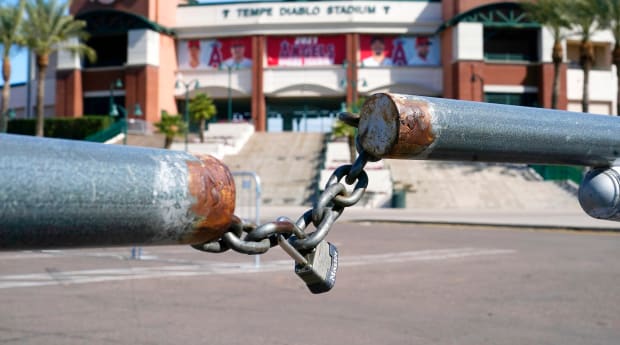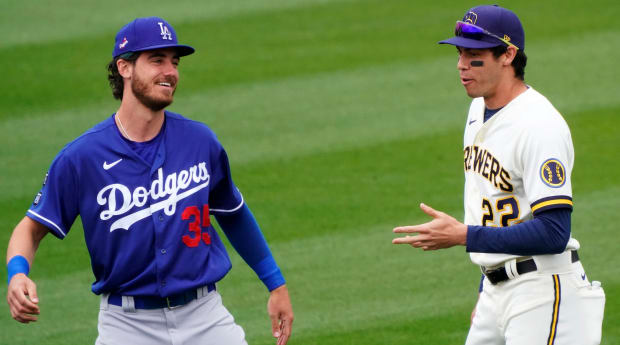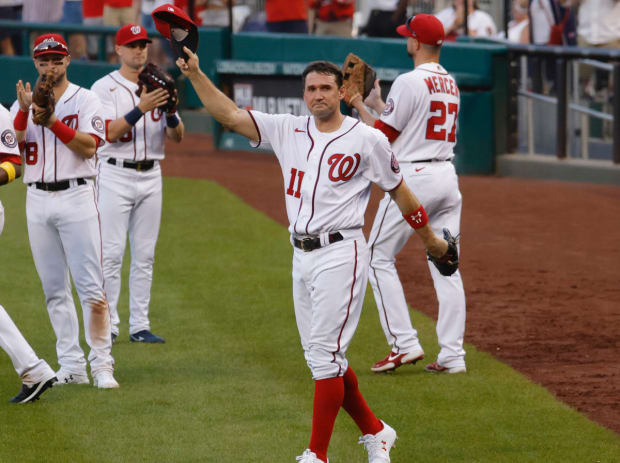With 10 days to go until the MLB lockout impacts the scheduled start of the regular season, the two sides have made little progress on a new collective bargaining agreement.
Yesterday in Manhattan, where temperatures were in the 50s and the atmosphere ideal for some spring baseball, the representatives for the owners arrived at the union’s headquarters, stayed for 15 minutes and then retreated to go over the latest proposal from the players. Dan Halem, the lead negotiator for the league, remained for another 20 minutes, talking with the union’s Bruce Meyer—a conversation that Chelsea Janes of The Washington Post reported was “candid” and a “not unexpected heart-to-heart.”
No matter the tenor of that conversation, it’s difficult to imagine a new CBA coming together by the end of the month. Still, there are a few interesting things to take away from yesterday’s session, and maybe, just maybe, a sign of life.

AP Photo/Ross D. Franklin
The Proposed Changes
The Players Association focused its new proposal on getting more players paid more money earlier in their careers, a core issue for the union. The two changes the players made in this offer deal with arbitration eligibility and the bonus pool for pre-arb players.
First, the union asked that 80% of players with more than two years of service time qualify for arbitration. In the last few CBAs, the pool of arbitration-eligible players with two-plus years of service time—known as Super 2s—was limited to 22% of the players with between two and three years of service time. The owners have said all along that they won’t budge on arbitration eligibility, while in previous offers, the union has asked that all players qualify for arbitration after two years of service instead of three.
The second change is a response to the first. The players proposed a pre-arbitration bonus pool worth $115 million that would be divided among the top 150 pre-arb players. The union’s previous bonus pool offer was $100 million for the top 30 performers.
Through one lens, the union is taking a tactic straight from the league’s playbook—make one concession but ask for more elsewhere. Few things are more irritating than a taste of your own medicine, so if nothing else, the players can take solace in ticking off the owners. That said, this is actually a quite reasonable offer, even though, as I’ve previously written, I am very much against instituting any pay-for-performance policy into the CBA. Think of it this way: in this new proposal, the percentage of two-plus players eligible for arbitration decreased by 20%. So, to ensure that more pre-arb players get a bonus, one that is of considerable value, the union increased the number of players who could qualify for the bonus.
The Blockade
The one thing that really irks me about the league’s reaction to the latest proposal is it's reinforcing the notion that it won’t move on arbitration eligibility. More and more, it’s becoming clear that for nearly every specific proposal the union makes to change the pillars of prior CBAs—free-agent eligibility, arbitration eligibility and revenue sharing—the league responds with something to the effect of “this is a nonstarter” or “we won’t move on this.”
The players then return with a new offer, one that makes a fairly substantial concession—dropping their request to expand free-agent eligibility, lowering the amount by which to cut revenue sharing for small-market clubs and now decreasing the percentage of arbitration-eligible players with at least two years of service time—only to get the same answer from owners.
This is supposed to be a negotiation between two parties. The whole purpose of collective bargaining is for employers and employees to come to an agreement that benefits both sides, and to do that, each party needs to give some ground in order to gain some elsewhere. In theory, that is what’s happening here: the owners and players are working toward a compromise. In reality, though, the union is mostly bargaining with itself. It’s time for a new strategy.
The Leverage
One of MLB’s top priorities in this negotiation is expanding the postseason. The league wants the number of teams in the playoffs to increase from 10 to 14 teams. The players, who previously said they are willing to add two teams instead of four, threw the owners a nasty hook yesterday.
As Sportsnet Canada’s Ben Nicholson-Smith reported last night, the players told the owners they won’t agree to expanded playoffs if they don’t play a full 162-game season and are not paid their full-season salary. That would mean either a deal would have to be reached before March 1, or the owners would have to end the lockout at that point without a new CBA in place, so the players would have enough time to report to spring training and get ready for Opening Day, scheduled for March 31.
By threatening expanded playoffs—and the millions of dollars in TV revenue that MLB would gain with it—the players have imposed a deadline with significant financial stakes for the owners if they don’t meet it. It’s not a coincidence that MLB announced today that the two sides will meet every day next week for in-person bargaining sessions. This is the urgency for which we’ve all been waiting.
Then again, if this episode of the lockout is akin to Star Wars: A New Hope, then we’d be foolish not to expect the empire to strike back. It’s premature to expect an agreement by the end of the month; the gulf between the two sides still appears to be too wide to bridge in one week’s time. It’s hard to know today if enough owners will prioritize postseason expansion over the concessions they’ll have to make to a lot of those “nonstarters” to reach a deal with the players. The league needs at least two-thirds of the owners to sign off on a new CBA, so a full season could come down to eight owners digging in their heels on a specific set of issues.
Think of the lockout as a batter stuck in a really, really bad slump. He’s 0-for his last three weeks, and it’s easier to expect he’ll never get another hit again than to hope that he’ll snap out of it his next time up. He looks lost and falls behind in the count, 0–2; then, he flails his bat at the pitch, just so that he doesn’t go down looking, and fouls it off.
It’s all still so bleak. The odds are slim that the season will start on time. And yet, just like the woeful batter who barely gets a piece of the ball, the ever-fleeting chance of playing a full 162-game season somehow, inexplicably, remains alive.
Have any questions for our team? Send a note to mlb@si.com.
1. THE OPENER

Rick Scuteri/USA TODAY Sports
“Baseball never saw anything quite like the Yeli & Belli Show of 2019… Just two seasons later, Yelich and Bellinger are two of the biggest enigmas in baseball.”
That’s Tom Verducci, in his excellent deep dive into the struggles of Christian Yelich and Cody Bellinger—and whether they can return to greatness. You can read his entire column below:
What Went Wrong With Christian Yelich and Cody Bellinger? by Tom Verducci
2. ICYMI
Yesterday, former Angels communications director Eric Kay was found guilty on two counts relating to the death of Tyler Skaggs: distributing counterfeit pills laced with fentanyl that led to Skaggs’s death and conspiracy to possess with intent to distribute.
He faces a minimum of 20 years in prison for the distribution charge and up to 20 years for the conspiracy charge.
Angels Staffer Found Guilty for Distributing Fatal Drugs to Tyler Skaggs by Nick Selbe
The trial was incredibly sad and a harrowing reminder of the prevalence of opioids in our society. Five players testified that Kay had provided them with oxycodone; Matt Harvey, who was one of the players who received drugs from Kay, admitted that he too had once given Percocets to Skaggs. Harvey also said that he was using cocaine during his time with the Mets and the Angels. Harvey, who is currently a free agent, was granted immunity in exchange for his testimony, but he still faces a suspension from MLB for distributing drugs to Skaggs.
Five months after Skaggs’s death in July 2019, MLB and the players union amended their Joint Drug Agreement to begin testing for opioids. Tom Verducci reported Wednesday night, “In the two seasons of such testing, covering more than 12,000 tests, there have been no opioid-related violations, according to a source familiar with those results.” Of course, this doesn’t mean that nobody in baseball is using illegal opioids.
One longtime high-ranking club official told Verducci that as far as he knows, opioid abuse hasn’t been an issue for his team. But, the official added, “That doesn’t mean it wasn’t around, if only because of how pervasive it is in society. But that situation [with the Angels] strikes me as isolated.”
MLB Drug Testing Finds No Opioid Violations in Two Seasons by Tom Verducci
On Monday, ESPN's Jeff Passan reported that MLB, in its most recent CBA proposal, asked to cut hundreds of jobs for minor-league players. In Tuesday’s SI:AM newsletter, Dan Gartland wrote a helpful guide to understanding MLB’s latest threat to the minors. You should definitely check that out below and can sign up to get the free newsletter at SI.com/newsletters.
MLB Goes After Minor Leagues (Again) by Dan Gartland
MLB made it official today that spring training will be delayed, with the earliest possible pre-season games beginning March 5, though that will depend on what happens at the bargaining table over the next week or so.
MLB Postpones Spring Training As Lockout Continues by Madison Williams
In far less depressing news, unless you’re a Nationals fan, Enrique Rojas of ESPN Deportes reported that Juan Soto turned down a 13-year, $350 million contract extension before the lockout began. Soto, who is under club control for three more years, is this generation’s version of Ted Williams, and he could receive baseball’s first $500 million contract when he finally hits the open market after his age-25 season.
Because there are no major-league transactions happening during the lockout, Nick Selbe took a stab at projecting the best fits for where Soto could eventually sign. You can read his column below, and be sure to bookmark that link so you can dunk on him when Soto signs with the Pirates instead of the Diamondbacks.
Juan Soto’s Way-Too-Early Free-Agency Destinations by Nick Selbe
And lastly, Ryan Zimmerman announced his retirement Tuesday night. Sorry again, Nats fans.
Zimmerman is one of 60 players who spent his entire career with one organization and played for at least 15 years. But, more than that, as Emma Baccellieri writes in her touching tribute to Mr. National, “he and the franchise grew up alongside one another.”
Ryan Zimmerman Stands Among Precious Few Franchise-Defining Players by Emma Baccellieri
3. WORTH NOTING from Tom Verducci
It’s getting increasingly harder to be an optimist that we will see a full baseball season.
Five days after the owners made a 130-page proposal, players made two tweaks to core economic issues yesterday—one that increased the monetary gap between the two sides on a bonus-pool proposal and one that cut their asking price of expanded arbitration—a topic the owners have held as a non-starter. The session lasted about 15 minutes. There was no need to talk further. They remain widely apart on competitive balance tax thresholds and rates.
Keep this in mind: the 1990 lockout was settled in mid-March, and the 162-game season was saved. They did so by pushing Opening Day one week and by getting CBS to move the World Series in order to add games at the end. Neither gerrymandering tactic seems an option now, in part because the TV schedule is less flexible, especially with an expanded postseason coming. And commissioner Rob Manfred doesn’t want seven-inning doubleheaders to make up games.
That means starting about March 1 (with two days to ratify and a 28-day spring training), every day without an agreement is a day of games lost that aren’t coming back. The two sides are scheduled to meet again Monday. That puts them on the clock: one week to somehow bridge the enormous gap between them.
4. TRIVIA! from Matt Martell
Before we get into this week’s question, here is the answer to the one I asked last Friday.
Last Week’s Question: There are nine members of the 600 Home Run Club. Two of them never hit 50 home runs in a single season. Can you name them?
Answer: Henry Aaron, Albert Pujols
This Week’s Question: Following Zimmerman’s retirement, there are three active players who have spent their entire careers of at least 15 seasons with only one team. Who are they?

Geoff Burke/USA Today Sports
5. MAILBAG! from Emma Baccellieri
Welcome back to another round of the mailbag. And we’re ending on a lighter note: Since the rest of this newsletter was lockout-centric—like, of course, just about all baseball coverage right now—I thought I’d pick some questions that focused elsewhere this week. Questions for next time? mlb@si.com, or @emmabaccellieri on Twitter.
Do we see an increase in strikeout rates again this year? – Geoff
I’ve been wondering if we’ll see this trend begin to change. There’s something of a natural cap on so many of the factors that have been behind it—guys can throw only so hard, there are only so many pitchers who can be used in a season and the average length of an appearance can only be cut down so much. This means that, yes, strikeouts can keep going up… but probably not at the same rate that they have been. Here are the numbers from the last few seasons:

There’s some obvious weirdness in there with the pandemic season in 2020. But even so—the rate of increase seems to be slowing. I’d guess that in ’22, we see the strikeout rate keep bumping up, but only by a few tenths of a percentage point if that.
If a new truth in advertising law required that every team field their team name as a starter, what position would most teams replace, and what teams would handle the requirement best other than the Athletics? (Sox have to play pairs of socks, not people wearing them.) – Christopher
The position has gotta be an outfielder, right? It’s your best bet of limiting the potential damage since you have two actual baseball players to buttress your cub/marlin/pair of socks, but you can still play up whatever strengths there are to be found in the new teammate. (Although I would be intrigued by Detroit putting a Tiger at second base… on one hand, he can’t possibly field with his paws, but on the other, who’s going to want to run the bases if there’s a carnivore at second?) Here are my top five picks:
5. Yankees: Simply being human counts for a lot in this context.
4. Twins: Double the manpower!
3. Giants: No fly ball will ever leave the park with a giant in the outfield.
2. Rangers: Put him in center. He’s got the… range.
1. Guardians: This one works so well partially because we haven’t actually had a chance to see it interpreted as a concept much yet. But if you are supposed to guard something, to act as a steward, I think that means you’ll be an excellent fielder as you do everything possible to take care of the ball.
(Honorable mention in this capacity goes to the Angels. Which, of course, we already know do well in the outfield.)
Which current MLB player most resembles the production/output Pablo Sanchez would produce in a hypothetical MLB? – Erik
Off the top of my head, Pablo Sanchez was most memorable for his speed and his power: A classic 30-30 guy! A healthy Ronald Acuña, Jr., popped to mind, as did Fernando Tatis, Jr., or maybe José Ramírez. But then I looked it up just to be sure—I’m a few years removed from my Backyard Baseball days, after all—and realized… Pablo can pitch, too. Of course. The best all-around guy in the game can be only one: Shohei Ohtani.
That’s all from us today. We’ll be back in your inbox next Friday. In the meantime, share this newsletter with your friends and family, and tell them to sign up at SI.com/newsletters. If you have any questions or comments, shoot us an email at mlb@si.com.